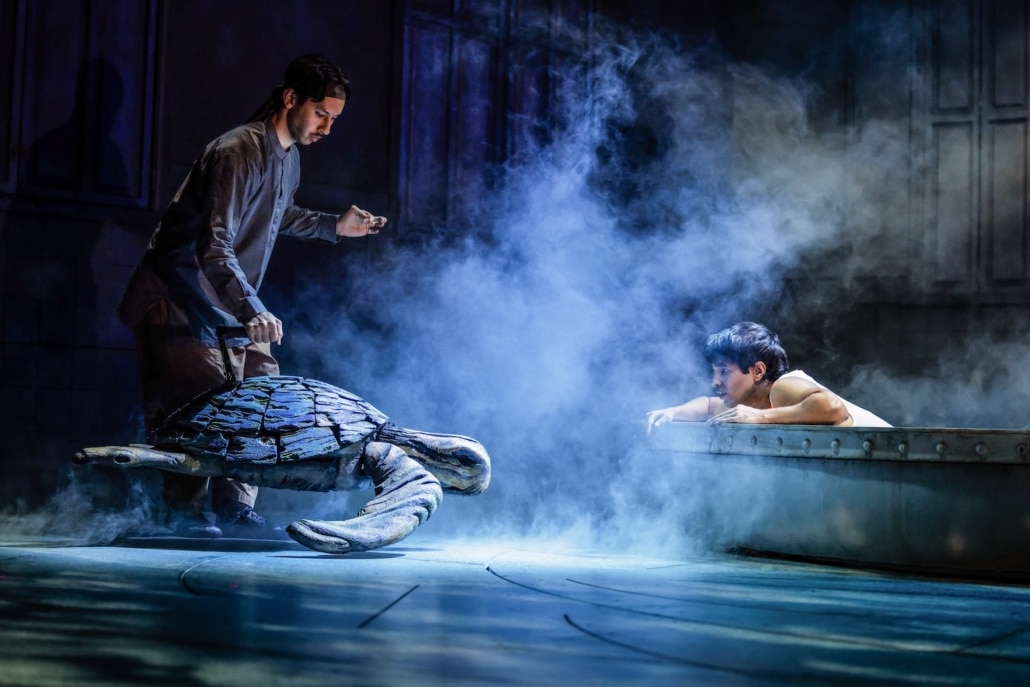DCPA NEWS CENTER
Enjoy the best stories and perspectives from the theatre world today.
Enjoy the best stories and perspectives from the theatre world today.
Click here to see more Life of Pi interviews

Taha Mandviwala as ‘Pi’ and Austin Wong Harper (puppeteer) in the National Tour of LIFE OF PI. Photo by Evan Zimmerman for MurphyMade, 2024
Provided by Life of Pi, Education & Resources Packet Team. By Susie Ferguson for Mousetrap Theatre Projects, 2022
Can you tell us about transferring the show to London?
The show was first performed at the Sheffield Crucible, which is an incredibly exciting space. We used the thrust configuration, with all of the audience looking down onto the stage. This made the use of the floor a really key part of the production and provided some incredibly exciting opportunities. Bringing it to the West End, we’ve reconfigured it to an end on staging, but the seats in the auditorium have been lifted so that this audience still get that same experience. We’ve also built the stage out into the auditorium, too.

Max Webster
The end on configuration has presented a few challenges, so we have made some changes to the blocking in London, as you would expect. I think the most technically challenging part of the play is the tiger training scene when all of the performance and design elements all work together to create that sense of peril and drama. It includes sound effects, trap doors, puppets, lighting, video projection, revolve cues – everything is working full blast!
What are the staging challenges of Life of Pi?
Life of Pi is a challenging novel to adapt because of the interpolation of the scenes at sea, with the more conversational scenes in the hospital. We have to ensure that we don’t lose momentum and tension in those scenes – that we sustain the audience’s engagement and interest.
Yann’s novel is an image which is expanded – a boy and a tiger in a boat! The first third is about the family, the epilogue is the second story with the two investigators who talk to Pi, and then the middle is an extended journalistic and scientific description about how Pi survives. It doesn’t have the same arc as a theatrical piece, so the challenge is to give the time at sea that vital shape.
My role as a director includes ensuring that the fundamental information and story is clear:
What was your approach to rehearsing the show?
The first time we made the show, we’d done a lot of Research and Development (R&D) and workshopping. On our first day we did a read through, which I usually do at the beginning of the rehearsal period. Read throughs are good to do both as an ice-breaker, but also a way into discussion, talking about the play and what it means, and the key themes that we think are important. We also did a movement session. We did an introduction to puppetry and talked about the practicalities of working together. We had some principles about how we’d be with each other – including equality, diversity and inclusion.
Working with Finn there was a lot of practical and technical direction as well as the artistic process of telling the story. Each time the puppet does something, it has to be physically ‘written’: not physically written down, but it needs working out and creating with precision. Everything is collaborative.
How did your own training inform your work on this production?
Part of my training was at the Jacques Lecoq School in Paris. That training was great in its focused thinking about what one does with one’s body. For Life of Pi that focus is about what you would do on a beach in Mexico, in contrast to how you would use your body in a zoo. Whilst you are being assisted with the projections in the show, the story is held in the bodies of the actors and everything around them is supporting that.
What do you want the audience to experience as they watch Life of Pi?
Theatre is something that happens between the actors and the audience in a triangulation with the play we’re performing. When I’m directing, I constantly consider the relationship with the audience and I don’t think it’s a one way interaction: it’s a shared act of imagination. I’ve been struck by the different thoughts people have had when they come away from the show and I really like the way they resonate with the story. Some people are very interested in the theology of the play, whilst others see it as an epic story of survival. Art is not didactic. The play means different things to different people.
Yann gets asked a lot about which of the stories is ‘real’, but Yann has said that he wanted to write a very democratic novel – that people have a choice. We want the play to be an emotionally effective story – but again there are various different emotions that you might feel when watching it.
